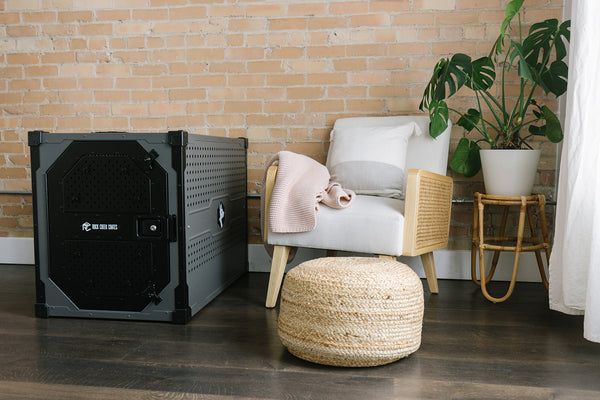Some dogs have a lot to say, and they’re going to make sure you hear all of it. Learning how to get a dog to stop barking in a crate is possible, and what it really takes is a bit of patience and a willingness to understand your dog on a deeper level. It’s important to remember that dogs inherently want to please their humans, and they’re happiest when they’re making you happy. When they’re barking in their crate, they’re trying to communicate something and what they really want is to be understood.
Why Is My Dog Barking In Their Crate In The First Place?

In order to get to the bottom of how to get a dog to stop barking in a crate, it pays to learn why they may be barking or whining in their crate in the first place. Learning how to stop a dog from whining in a crate is much the same as learning how to stop them from barking – understand what they’re trying to communicate, and better meet their needs. Some common reasons that dogs bark in their crate, according to Pets Radar, include:
1. They just want out – This is most common with dogs who struggle with separation anxiety. They don’t want to be in their crate; they want to be with you. Whether you’re sitting on the sofa, laying in bed, or leaving the house, they feel more comfortable by your side and their inability to do so is causing them stress. How can they communicate or try to release that stress? It’s most often expressed through barking and whining.
2. They’re bored – Imagine feeling under-stimulated and being told that you have to sit in a chair, be quiet, place your smartphone on the table, and settle down – you’d likely feel pretty discontent pretty quickly. Dogs are the same. When a dog is under-stimulated throughout the day, then told to settle in their crate, they’ll often express those feelings of boredom or discontent through barking or whining.
3. They need to relieve themselves – According to Nature.com, dogs have evolved alongside humans in a very sophisticated way over the course of many thousands of years. You can see this incredible co-evolution particularly well in their communication skills. While we don’t speak the same language, it rarely feels as though there’s a difficult language barrier between humans and their dogs. When a dog needs to go outside, and they’re in their crate, they know to use their barking, whining, or other vocal cues to get our attention and let us know that it’s time for a quick trip around the block or to their backyard.
4. They’re hungry – Making a quick trip outside isn’t the only need dogs know how to communicate to their humans. Humans don’t like going to bed with a growling stomach, and neither does your dog. A dog may bark, whine, or struggle to settle down in their crate if they’re feeling in need of a little snack.
5. They don’t like the placement of their crate – Your dog’s crate is their safe space, their calm down space, and their relaxation space – so the area you place your crate should reflect those things. If you have the crate placed in a high-traffic or noisy area of your home, your dog may find it difficult to settle in and feel comfortable while spending time in it. If you find your dog barking or whining in their crate when there’s hustle and bustle around, they may be communicating their need for a quieter environment.
6. They’re sensing something strange in their environment – When a dog hears an odd noise, notices a different smell, or simply senses something has changed in their environment, their first instinct is to go investigate. If your dog is in their crate while they smell something cooking, hear a new sound, or senses someone is outside, they may bark or whine in an effort to communicate their need to check out what might be going on.
What Can You Do About It?
Knowing why your dog may be barking in their crate is only half the battle; now you need to figure out just what to do about it. No matter the reason your dog may be barking there is a solution to the problem. First try to identify the need, and once it’s identified, try to match it to a potential solution. Solutions to how to get dog to stop barking in crate include:
1. Exercise your dog well before crate time – A tired dog is a happy dog, especially when they’re being asked to go in their crate. Your dog already associates the crate with calm and relaxation, and after a great bout of exercise they’re really ready to settle in. If you notice your dog tends to bark or whine in their crate when feeling bored or under-stimulated, this could be just the solution you’re looking for. Alternatively, a tired dog may find it more manageable to overcome separation. According to Veterinarians.org, both mental and physical exertion have been shown to help ease separation anxiety symptoms in dogs and may help them to better acclimate to their crate long-term.

2. Give them a potty break before they go in their crate – In order to avoid the potty barking, making sure to take your dog outside before crate time is important. If your dog has been in the crate for some time, a brief trip to relieve themselves can help you to avoid the barking issue altogether. For housebreaking puppies, who may bark to “challenge” crate time as well as asking to relieve themselves, take the puppy on a quick and to-the-point trip to relieve themselves, and then return them to the crate immediately after. This lets them know that barking doesn’t help them to “win” the challenge, but it will get their immediate needs met.
3. Provide a snack beforehand – Before placing your dog in the crate, providing them with a small snack can help them to avoid feeling the hunger pangs that make them feel the need to bark in the first place. This small snack can be a special treat, a handful of their food, or anything that can curb hunger quickly and easily.
4. Move the crate to a calm and quiet space – If your dog can’t seem to settle down in their crate, the location might be the issue. Try moving the crate to a calm, relaxed, and quiet space it would be easy to take a good nap in. This limits distractions, helps your dog to wind down, and takes away any stressors they may be exposed to in a more high-traffic environment.
What If Nothing Seems To Work?
If nothing seems to work to figure out how to stop a dog from barking in a crate or whining in their crate, you may need to go back to crate training 101. If you’ve never properly crate trained your dog before, the process is easy – it just takes a little patience.
First choose a safe, appropriately sized, and comfortable crate. If your dog suffers from separation anxiety, a separation anxiety focused crate may be most beneficial. The size of the crate should be enough that your dog can step inside, turn around, and lay down comfortably.
First begin with short trips into the crate, with the door open, to retrieve treats or eat a meal. This builds positive association with the crate from the very beginning. Once your dog is comfortable going inside of the crate, move a little further into having your dog enjoy bones, treats, or puzzles in their crate for longer durations still with an open door.
As your dog grows even more comfortable, try closing the door for just a few seconds at a time to get them used to closed-door crate time. Start with about 30 seconds, close the door, turn your back, and wait. Your dog may bark, they may whine, but they’re simply communicating some discomfort with a new experience. As your dog acclimates to short closed-door crate times, ramp the time up to a couple of minutes, to about ten minutes, to fifteen minutes, and work your way up to 30 minutes. During this time, stay in the room with them as they get more comfortable.
Each time they successfully spend time in their crate, make sure to praise, treat, or otherwise make sure your dog knows they’ve done a great job. Pretty soon, you’ll be able to close the crate door, leave the room, and your dog will remain calm and comfortable knowing they’re in their safe and happy space.
Occasionally, a dog may develop a short-term aversion to their crate that perhaps they haven’t had before or haven’t had since puppyhood. This could be caused by big life changes, like a move or a change in your family structure, but they’re likely looking for comfort during uncertain or uncomfortable times for them. In these instances, getting back to the basics and reintroducing the crate as a happy and soothing place works to overcome these (sometimes frustrating) challenges.

Communication Is Key
It can be frustrating to find the perfect crate, go through the trials and tribulations of crate training, and still find you and your dog struggling with their crate time with barking or whining. It’s important to remember, however, that barking and whining are simply communication behaviors, and your dog is likely just as frustrated as you are in that moment. Learning how to communicate with your dog is a solution to these frustrations, and one that builds your bond even stronger.

